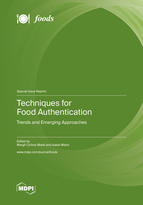Techniques for Food Authentication: Trends and Emerging Approaches
A special issue of Foods (ISSN 2304-8158). This special issue belongs to the section "Food Analytical Methods".
Deadline for manuscript submissions: closed (30 June 2021) | Viewed by 36260
Special Issue Editors
Interests: analytical chemistry; food chemistry; immunoanalytical and molecular biological methods
Special Issues, Collections and Topics in MDPI journals
Interests: allergen detection; DNA analysis; food analysis; food authentication; GMO detection; food chemistry; real-time PCR
Special Issues, Collections and Topics in MDPI journals
Special Issue Information
Dear Colleagues,
According to national and international legal regulations, food producers and retailers are not allowed to deliberately give false or misleading statements on food labels. Any information on composition, quality, geographic origin, and processing of food products must be correct. Studies, however, indicate that fraudulent practices are a global phenomenon.
Food authentication is a challenging task. A broad spectrum of methodologies is necessary to address the different aspects of food adulteration. Methods should be sensitive, accurate, reproducible, robust, and applicable to raw and highly processed foodstuffs to be suitable for routine analysis.
This Special Issue will publish innovative research on all aspects of food authentication and all food types, with an emphasis on method development and validation. The issue covers established methodologies, e.g., DNA-based, spectroscopic/spectrometric, chromatographic, and electrophoretic methods, but also emerging approaches. Both review and original research articles are welcome.
Prof. Dr. Margit Cichna-Markl
Dr. Isabel Mafra
Guest Editors
Manuscript Submission Information
Manuscripts should be submitted online at www.mdpi.com by registering and logging in to this website. Once you are registered, click here to go to the submission form. Manuscripts can be submitted until the deadline. All submissions that pass pre-check are peer-reviewed. Accepted papers will be published continuously in the journal (as soon as accepted) and will be listed together on the special issue website. Research articles, review articles as well as short communications are invited. For planned papers, a title and short abstract (about 100 words) can be sent to the Editorial Office for announcement on this website.
Submitted manuscripts should not have been published previously, nor be under consideration for publication elsewhere (except conference proceedings papers). All manuscripts are thoroughly refereed through a single-blind peer-review process. A guide for authors and other relevant information for submission of manuscripts is available on the Instructions for Authors page. Foods is an international peer-reviewed open access semimonthly journal published by MDPI.
Please visit the Instructions for Authors page before submitting a manuscript. The Article Processing Charge (APC) for publication in this open access journal is 2900 CHF (Swiss Francs). Submitted papers should be well formatted and use good English. Authors may use MDPI's English editing service prior to publication or during author revisions.
Keywords
- food authentication
- method development
- method validation
- geographic origin
- species identification
- DNA based techniques
- chromatography
- spectroscopy
- spectrometry
- electrophoresis
- chemometric methods








